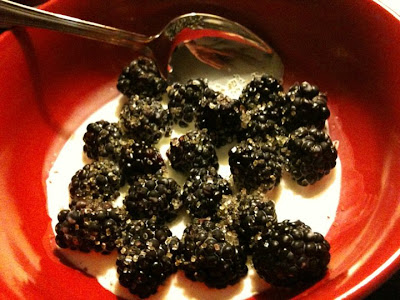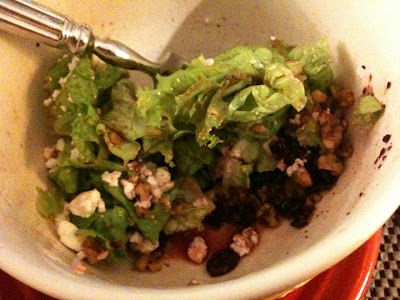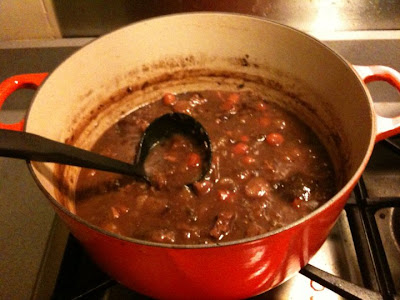Sunday, September 18, 2011
Potato Soup
Have fun!
Potato Soup a la Anne Lane
- 1 medium yellow onion, diced
- about 6 Yukon Gold potatoes, each about the size of your fist (or my fist, since it's not that big), diced-- you can use them peeled or unpeeled, but I like them unpeeled
- 1 carton good chicken or veggie stock
- salt and pepper to taste
- 1 tbsp olive oil
- 1 tbsp butter
- 1- 8 oz. block good cheddar cheese, as sharp as you like it, chopped into small pieces (I use Cabot's Seriously Sharp White Cheddar-- yum)
- about 2 tbsp milk or cream
- bacon bits and extra cheese to top, if desired
In a Dutch oven or good sized pan (I used a 4 qt pan), heat the butter and olive oil over medium-low heat until the butter has melted and everything's bubbling. Add the diced onion, sautéing until translucent.
Add a bit of your stock and deglaze the pan, scraping the pan with a nylon or silicone spatula or spoon to get the browned bits up into the stock. Add the rest of the stock, then add your potatoes.
Season with some salt and pepper. Don't go overboard as the flavors will concentrate. Give the pot a good stir, then set your timer for 30 minutes and let the potatoes, onion, and stock cook so that the potatoes get tender.
When the potatoes are good and tender, use either a potato masher (for a chunkier texture) or an immersion blender (for a velvety texture) to get them to the consistency you prefer. Swirl in your milk or cream and your cheese. Stir and adjust seasonings. Let this simmer for a couple of minutes to make sure the cheese melts, then give it a good stir to blend.
Serve in bowls with your preferred toppings. I like some bacon and extra cheese personally. This makes about 6 decent servings.
Enjoy!
Tuesday, September 6, 2011
Fresh Tomato Sauce a la Scarpetta and Smitten Kitchen
SK's recipe calls for plum tomatoes, as does Scott Conant's (Scarpetta is his baby). I decided that I have seen such exquisite tomatoes around that I would use what I could get fresh here in my town. This ended up being about half heirloom tomatoes and half plum tomatoes, both of which looked perfect! I can tell you from the outcome that this dish is a keeper. I melded SK's version with the Scott Conant versions I found online, tweaking to my liking.
You can do much of this ahead of time, refrigerating the unfinished sauce until you're ready. It seems to me that you could get it two-thirds of the way finished and then freeze, but I haven't tried that yet. In any case, the recipe quantities say that this makes 4 smallish portions. If you're serving it for company, I'd recommend either using this as a true pasta course, or supplementing with a lovely salad.
Fresh Tomato Sauce a la Scarpetta and Smitten Kitchen:
- 3 pounds fresh, ripe tomatoes (if using plum tomatoes, Conant says you'll have about 20)
- 1/2 teaspoon kosher salt (This is lighter than the recipes I saw, but Conant recommends going lights as the salt will concentrate as the tomatoes cook.)
- 1 large clove garlic, thinly sliced, or a couple of smaller ones, thinly sliced
- Pinch of crushed red pepper flake
- Small handful fresh basil leaves, with a couple of extras for garnish
- 1/4 cup olive oil
- 1/2 cup or so grated good quality parmigiano (Reggiano if you've got it, but I used an artisanal one that was nice, and it was shredded. It was a little different in texture than the grated would have been, but still quite good.)
- 1 tablespoon butter (or 2, if you're feeling like a richer sauce)
- freshly cracked black pepper to finish
- enough pasta for 4 servings (I used whole wheat spaghetti-- Ronzoni Healthy Harvest)
Sunday, July 10, 2011
Taco Seasoning
 I have long looked to tacos as a super-quick and comforting meal. Grab your chosen protein (beef, chicken, pork, turkey, or tofu), some taco shells, toppings, and a packet of taco seasoning. Done. Or so I thought.
I have long looked to tacos as a super-quick and comforting meal. Grab your chosen protein (beef, chicken, pork, turkey, or tofu), some taco shells, toppings, and a packet of taco seasoning. Done. Or so I thought.- -1 tablespoon chili powder
- -1/4 teaspoon garlic powder
- -1/4 teaspoon onion powder
- -1/4 teaspoon crushed red pepper flakes (I think that next time, I will use 1/8 teaspoon of red pepper flakes and 1/8 teaspoon of chipotle pepper powder)
- -1/4 teaspoon dried oregano
- -1/2 teaspoon paprika
- -1 1/2 teaspoons ground cumin
- -1 teaspoon sea salt (I think you could use about a 1/2 to 3/4 teaspoon)
- -1 teaspoon black pepper
- -2 tablespoons cornstarch
Monday, June 20, 2011
Blackberries
 One of my very early memories is of drinking blackberry juice, purchased at Ukrops Supermarket in Richmond. It was absolutely delicious and one of the few healthy things I remember loving as a child, which is perhaps why my mom made sure we had it as often as we could. It disappeared from their shelves, but my taste for blackberries has remained, leading to such adventures as picking blackberries at summer camp-- to the dismay of the camp director, who worried that we would get bitten by snakes!
One of my very early memories is of drinking blackberry juice, purchased at Ukrops Supermarket in Richmond. It was absolutely delicious and one of the few healthy things I remember loving as a child, which is perhaps why my mom made sure we had it as often as we could. It disappeared from their shelves, but my taste for blackberries has remained, leading to such adventures as picking blackberries at summer camp-- to the dismay of the camp director, who worried that we would get bitten by snakes! Wednesday, June 8, 2011
Crispy Treats...with a Twist
 (Confession time: this is not my photo, but it is a photo of the delectable treats as made by my friend and sorority sister Meg Hogan. Mine were all gone before I could get a picture!)
(Confession time: this is not my photo, but it is a photo of the delectable treats as made by my friend and sorority sister Meg Hogan. Mine were all gone before I could get a picture!)Tuesday, June 7, 2011
Steamed veggies made even easier!
 I was invited to a parish party tonight. Hating to show up empty-handed, I thought of what I had around the house so that I could contribute something yummy. I remembered the exquisite asparagus I had bought from The Old Farm Truck Market in Lively, VA and thought, aha! The rub in this plan was that I ran short on time between work and the party, plus I wanted to bring something cooling as it is, well, warmish (to put it mildly) here in the Commonwealth of Virginia. Thanks be to Alton Brown, I have now learned how to steam asparagus and other veggies in the microwave! Genius, genius, genius. All the good of the veggies, plus the kitchen doesn't get overheated. It's a win, win.
I was invited to a parish party tonight. Hating to show up empty-handed, I thought of what I had around the house so that I could contribute something yummy. I remembered the exquisite asparagus I had bought from The Old Farm Truck Market in Lively, VA and thought, aha! The rub in this plan was that I ran short on time between work and the party, plus I wanted to bring something cooling as it is, well, warmish (to put it mildly) here in the Commonwealth of Virginia. Thanks be to Alton Brown, I have now learned how to steam asparagus and other veggies in the microwave! Genius, genius, genius. All the good of the veggies, plus the kitchen doesn't get overheated. It's a win, win.Thursday, May 26, 2011
Salad Days
 I go through phases with salads. Once upon a time, I was a vegetarian and grew tired of salad being the only non-meat option, which led to their being long-absent from my diet. Fortunately, I'm happy to eat them now! Sometimes, I will eat them for weeks on end without tiring of them; other times, I can go for months without eating them or wanting them. Sometimes, it takes a fantastically fresh and delicious salad to get me back on the kick. Now that the weather is warmer, it's an excellent time to get back on the salad kick.
I go through phases with salads. Once upon a time, I was a vegetarian and grew tired of salad being the only non-meat option, which led to their being long-absent from my diet. Fortunately, I'm happy to eat them now! Sometimes, I will eat them for weeks on end without tiring of them; other times, I can go for months without eating them or wanting them. Sometimes, it takes a fantastically fresh and delicious salad to get me back on the kick. Now that the weather is warmer, it's an excellent time to get back on the salad kick.Wednesday, May 11, 2011
Roasted Asparagus
 As a child, I could not stand asparagus. Fortunately for me, especially in this season, I have grown to love the stuff. It is easy to prepare and quite lovely. This bunch came from an asparagus farm near Fredericksburg, Virginia. If you can get fresh local asparagus, you will be nicely rewarded! It has a beautiful flavor that blows the all-season stuff away.
As a child, I could not stand asparagus. Fortunately for me, especially in this season, I have grown to love the stuff. It is easy to prepare and quite lovely. This bunch came from an asparagus farm near Fredericksburg, Virginia. If you can get fresh local asparagus, you will be nicely rewarded! It has a beautiful flavor that blows the all-season stuff away.Monday, March 21, 2011
Lamb Stew
 St. Patrick's Day just came and went again for another year, and I repeated a successful lamb stew from last year. I found a basic recipe on Closet Cooking (well-suited for my NYC kitchen as that was microscopic) and tweaked it. The basics? Begin with good looking lamb (yes, this is a bit of a beauty contest) and select your veggies. Make sure to have good-quality beef stock on hand if you don't make your own. You'll want a good sized pot for this as well.
St. Patrick's Day just came and went again for another year, and I repeated a successful lamb stew from last year. I found a basic recipe on Closet Cooking (well-suited for my NYC kitchen as that was microscopic) and tweaked it. The basics? Begin with good looking lamb (yes, this is a bit of a beauty contest) and select your veggies. Make sure to have good-quality beef stock on hand if you don't make your own. You'll want a good sized pot for this as well.1 tablespoon oil
1.5 pounds lamb, give or take (cut into bite sized pieces)
2 onions (roughly chopped)
3 cloves garlic
2 tablespoons flour
1 Guinness (or other dark stout)
* beef stock
1 tablespoon rosemary (chopped)
1 tablespoon thyme (chopped-- pull it off of the woody stem first!)
1 bay leaf
salt and pepper to taste
4 white potatoes (cut into bite sized pieces)
8 carrots (cut into bite sized pieces)
1 handful parsley (chopped) garnish-- optional
Heat the oil in a large pot. Add the lamb and brown on each side. I remove the browned pieces from the pan and place them on a plate so as to avoid crowding.
Add the onions and saute until tender, about 5-7 minutes. It will take less time for this if you're using a cast iron pot. Add the garlic and saute until fragrant, about 1 minute.
Add the rosemary, thyme, bay leaf, salt and pepper, plus the potatoes and carrots if you want them more done. Add more beef stock if you add the veggies now.
Bring to a boil, reduce the heat and simmer uncovered until the lamb is fork tender, about 1-2 hours. Check it every so often for seasoning.
If you haven't already, add the potatoes and carrots and some more beef stock to cover. Bring to a boil, reduce the heat and simmer until they are tender, about 20-60 minutes depending on cut.
Serve in bowls with parsley (if using) and Irish soda bread on the side or some other good bread. Enjoy!!
Wednesday, March 16, 2011
Brunswick Stew
 Growing up, Brunswick Stew was always a favorite. My godmother, Mary Virginia, always had a fantastic recipe. Recently, she shared it with my mom, who shared it with me. The best part? It's still as wonderful and comforting and yet, it's not a difficult recipe! I'm posting her original recipe, along with my tweaks, which someone said make it Brunswitt Stew. From the reviews I got at the church supper, I'll take it. And without further ado, Brunswick Stew!
Growing up, Brunswick Stew was always a favorite. My godmother, Mary Virginia, always had a fantastic recipe. Recently, she shared it with my mom, who shared it with me. The best part? It's still as wonderful and comforting and yet, it's not a difficult recipe! I'm posting her original recipe, along with my tweaks, which someone said make it Brunswitt Stew. From the reviews I got at the church supper, I'll take it. And without further ado, Brunswick Stew!Sunday, March 13, 2011
Egyptian Red Lentil Soup
 I have always loved lentils. Among my early memories, I remember my mother serving us lentil soup, which I devoured. In the years that have followed, I have learned that there are different types of lentils, with different qualities. While living in New York City, I came upon red lentils and decided I needed to cook with them. They were too pretty to leave in the store!
I have always loved lentils. Among my early memories, I remember my mother serving us lentil soup, which I devoured. In the years that have followed, I have learned that there are different types of lentils, with different qualities. While living in New York City, I came upon red lentils and decided I needed to cook with them. They were too pretty to leave in the store!Sunday, February 13, 2011
Sugo alla Bolognese (Bolognese Sauce)

Wednesday, January 26, 2011
Strata!

A couple of weeks ago, I was invited to a ladies' brunch. I thought, "What can I bring? Ah! Strata!" This is from a recipe given to me by my friend Stevie Toepke when I was providing Easter breakfast food for the parish choir. I am trying really hard to resist calling it something like Erik Egg-Strata (which obviously worked so well that I was able to resist putting it into the blog post...or not). Whatever you call it, it's easy and delicious and adaptable to healthier eating, too. Add veggies or another type of breakfast meat. You can use egg substitute, etc., to tweak for healthier eating. You can also go whole hog (pardon the pun). Whatever you do, make it yours and make it often. You'll thank me.
-5 – 6 slices of bread (cubed)—I used a Tuscan style boule
-1 pkg ground sausage (I used Gunnoe’s Mild, but use one that tastes good to you!)
-2 c. grated cheddar cheese (I used Cabot’s Seriously Sharp White Cheddar, put in the freezer for a couple of hours, then cut into chunks and pulsed in the food processor)
-11 eggs (egg substitute works fine!)
-2 ½ c. milk (I used skim)
-1 ½ t. dry mustard
-1 t salt (and I added freshly ground pepper, so feel free to add some spices of your choice)
Cook sausage, drain and crumble.
Grease 9x13 inch pan and line pan with the bread cubes.
Layer w/ sausage and cheese.
Beat eggs with salt, milk, and mustard until foamy and pour over sausage/cheese/bread. (I sprinkled some shredded parmigiano reggiano on top.)
Refrigerate overnight. Remove 30 minutes before cooking and bake uncovered for 45 – 60 minutes at 350 degrees. It will be bubbly and beautiful.

